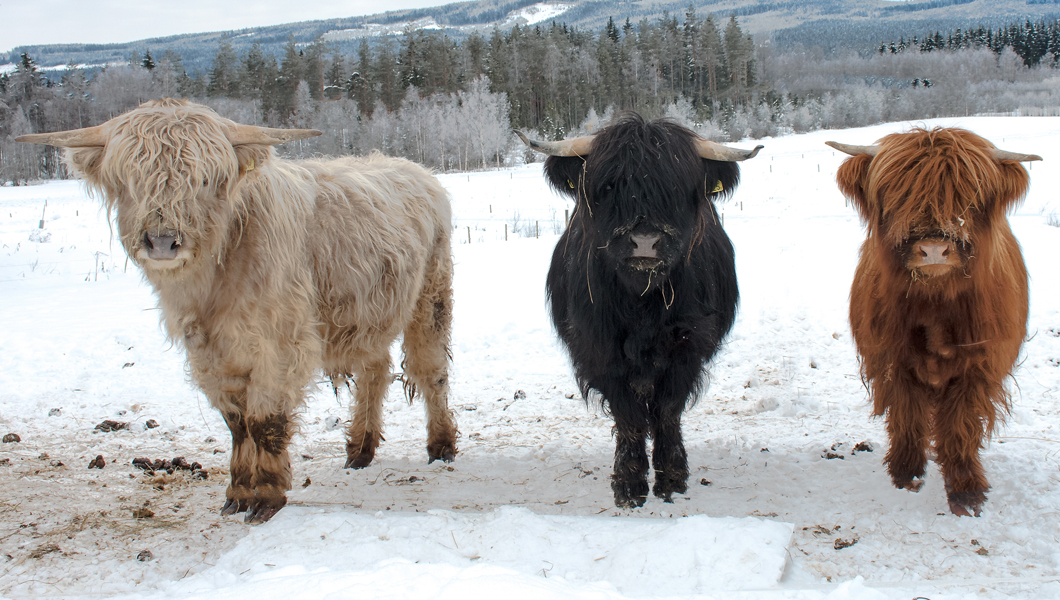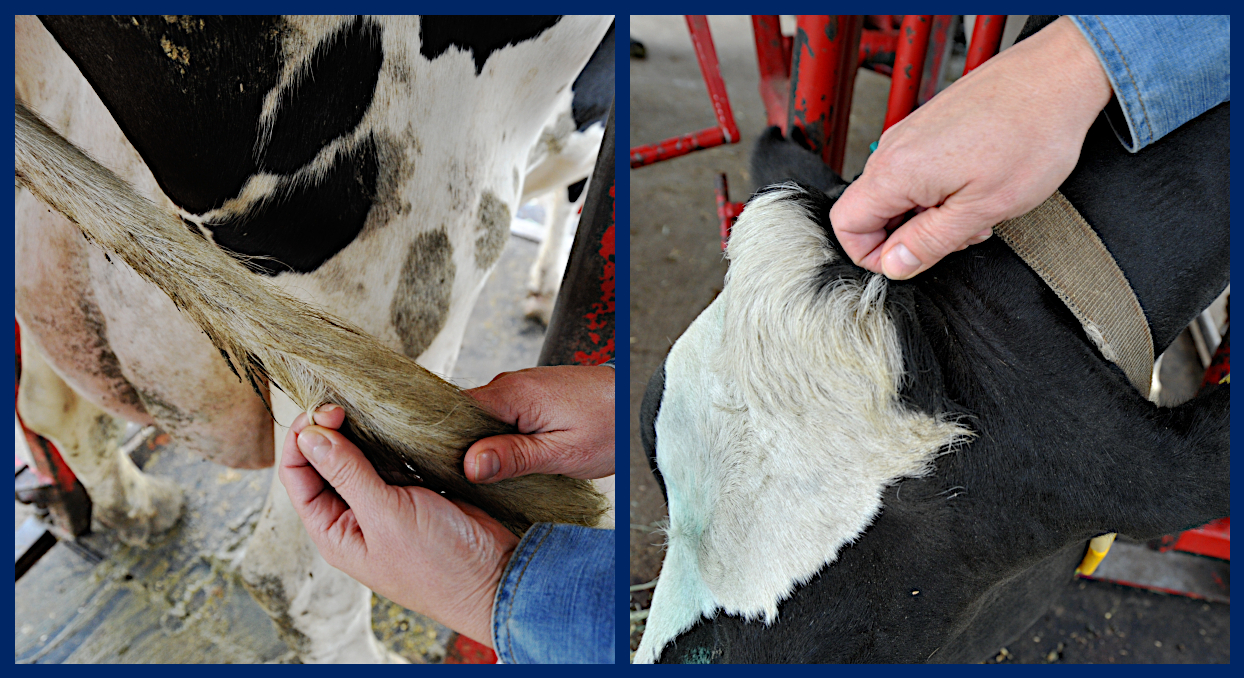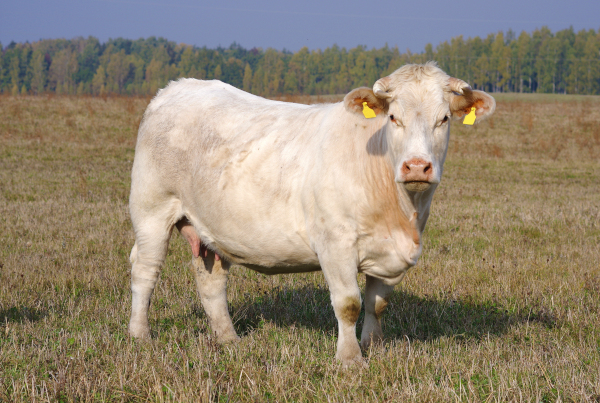Quick Summary

Click here for Price and Turnaround Time
Phenotype: A pale cream/white coat color in some breeds of cattle is produced by variants that have dosage-dependent effects on pigment, with a single allele diluting black to gray and red to pale red, and when two dilution alleles are present, a cream/white coat is observed.
Mode of Inheritance: Incomplete dominance
Alleles: N = Not dilute, Dc = Charolais dilution variant, Dh = Highland/Simmental/Galloway/Hereford/Wagyu dilution variant
Breeds appropriate for testing: Charolais, Highland, Galloway, Simmental, Hereford and Wagyu, crosses with these breeds, and composite breeds containing any of these breeds.
Explanation of Results:
- Cattle with N/N genotype do not exhibit diluted hair color. They cannot transmit a dilution variant to their offspring.
- Cattle with Dc/N genotype exhibit diluted pigmentation in their coats; coat color is gray or pale red. They will transmit the Charolais dilution variant to 50% of their offspring. Matings between two Dc/N animals have a 25% chance of producing a calf with a pale/white coat.
- Cattle with Dh/N genotype exhibit diluted pigmentation in their coats; coat color is gray or pale red. They will transmit the Dh dilution variant to 50% of their offspring. Matings between two Dh/N animals have a 25% chance of producing a calf with a pale/white coat.
- Cattle with Dc/Dc genotype exhibit diluted pigmentation in their coats; coat color is white. They will transmit the Charolais dilution variant to all of their offspring.
- Cattle with Dh/Dh genotype exhibit diluted pigmentation in their coats; coat color is pale cream. They will transmit this dilution variant to all of their offspring.
- Cattle with Dh/Dc genotype exhibit diluted pigmentation in their coats; coat color is white. These are considered compound heterozygotes and will transmit one of the PMEL17 dilution variants to all of their offspring.
Sample Collection
Most of the cattle DNA tests offered by the VGL are carried out using cells from the roots of a hair sample (roughly 20-40 hairs).
Hair samples should be taken from the switch of the tail, the poll, or the neck.

1. Clean (use comb if possible) tail switch, poll, or neck by removing all loose hair and foreign matter.
2. Use fingers or pliers to grasp approximately 8-10 hairs close to the skin and pull. Pull (do NOT cut) hair strands. Examine the end of hair strands for presence of root bulbs. Hair roots are necessary for DNA testing. If the majority of hair strands lack the root bulbs, discard hair and start again.
3. Repeat until you have approximately 20-40 hairs with root follicles attached.
4. Place the 20-40 hairs with root follicles attached in the envelope and seal with the animal’s ID written on the envelope. If hairs are long they can be taped to the submission form. Do not tape the roots.

5. Repeat steps 1-4 for each additional animal being sampled.
Note:
- Hair should be dry.
- If hair has excess dirt and debris, please brush out if possible before pulling hairs for sample.
- Do not cut the hair! The roots contain the DNA for testing.
- When sampling several animals in the same session, make sure that there are no hair strands in your hands to reduce the possibility of sample contamination. Clean hands and/or pliers if possible.

Dilute coat colors in Charolais, Highland, Galloway, Simmental, Wagyu, and American Hereford cattle are produced by variants in the premelanosome protein 17 (PMEL17) gene (also known as SILV). To date, two variants have been identified and associated with the dilute color phenotype in these breeds.
Gutiérrez-Gil et al (2007) identified a single nucleotide change c.64G>A associated with the dilution phenotype in the Charolais breed of cattle. This variant causes an amino acid change (p.Gly22Arg) and is thought to impact protein function. This variant is represented in our reports as Dc for dilute Charolais. All Charolais cattle possess the Dc variant, which explains their uniformly pale/white coat color.
Hecht (2006) identified a deletion of 3 bases (delTTC) in exon 1 of PMEL17 (summarized by Jolly et al 2008) which results in loss of a leucine amino acid in the PMEL protein sequence and is associated with the dilute phenotype in some animals of the Highland, Simmental, Galloway and Hereford breeds. This variant is also hypothesized to impact protein function. For simplicity, the PMEL17-delTTC variant is represented here and in our reports as Dh (for dilute Highland, although it is found in several other breeds). The effect of this variant is to lighten color of red- and black-pigmented hairs. The extent of color dilution depends on the dosage of the Dh variant (one copy or two) and on the genetic make-up of the MC1R gene that controls black/red pigment production.
Color dilution caused by the Dc and Dh variants is inherited as an incompletely dominant trait. The dilute hair color of heterozygous animals (Dh/N or Dc/N) is darker than that of homozygous animals or compound heterozygotes (Dh/Dc). On a red base color (MC1R genotypes e/e or E+/e), one copy of either PMEL17 variant (Dh/N or Dc/N) produces a lighter red or yellow shade of color while two copies (Dh/Dh, Dc/Dc) result in a pale cream/white color. On a black base color (MC1R genotypes ED/ED, ED/E+, ED/e), one copy of Dh dilutes black pigment to a brown/chocolate shade called Dun in Highland and Galloway breeds. Two copies of Dh dilutes black pigment to a pale color known as Silver Dun.
Color dilution variants in the PMEL17 gene are associated with “rat-tail syndrome” (RTS), a form of congenital hypotrichosis characterized by misshaped, curly and sparse dilute colored hair, and by missing hairs at the tail switch. RTS-affected animals have health and growth performance impairments. The RTS phenotype is typically expressed in cattle that have the dominant black MC1R-ED allele and one copy of a PMEL17 color dilution variant. Expression of RTS defect is variable. There is some evidence that supports another gene not yet identified but near PMEL17 may be critical for expression of the RTS phenotype.
A DNA test is available to determine if the PMEL17 variants are present in the genetic makeup of an animal that has a diluted or lighter than typical color phenotype. This test is appropriate for any breed or crossbred cattle that has Charolais, Highland, Galloway, Simmental, Wagyu or American Hereford content.
